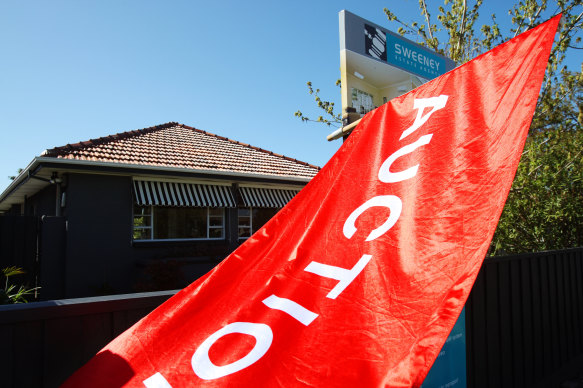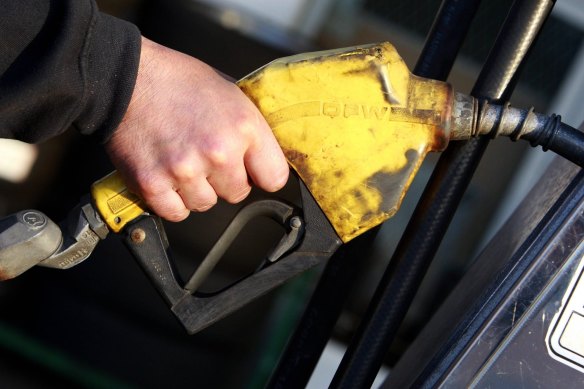By Shane Wright
The Reserve Bank faces its toughest decision in a generation that will force it to decide between its two core tenets - keeping inflation in check and ensuring all Australians have a job.
Some economists believe the result of Wednesday’s June quarter consumer price index is all the RBA will need to push the official cash rate - which has been steady since November - to a fresh-12 year high of 4.6 per cent at its early August meeting next week.

Potential home buyers, and those already with a mortgage, will be closely watching Wednesday’s inflation figures.Credit: Jessica Shapiro
On a $600,000 mortgage, a quarter percentage point increase would add about $100 to monthly repayments. Since the bank started lifting rates, just ahead of the 2022 election, the cumulative impact has already been more than $1400 a month.
Financial markets put the chance of a rate rise at one-in-four while economists linked to the nation’s major banks believe the bank will look through even a slightly-higher-than expected inflation rate and hold rates steady, worried a further increase will drive an already struggling economy into recession.
The bank board last met in mid-June, saying that recent economic data had been mixed which meant the bank remained “vigilant to upside risks to inflation”.
It also said it would be guided by information about the global economy, trends in domestic demand, the outlook for inflation and the jobs market.
The inflation figures to be released tomorrow will be vitally important to the bank’s discussions.
In the year to March, inflation was 3.6 per cent while the bank’s preferred measure - underlying inflation - edged down marginally to 4 per cent.
Economists believe headline inflation will lift to around 3.7-3.8 per cent, while underlying inflation will drift down to about 3.9 per cent.
But if headline or underlying inflation push higher, the RBA may be forced into action.
Key drivers of inflation are expected to be housing including construction and utilities. Rents, which over the past 12 months have climbed by 7.8 per cent, may edge down but will remain high.
House construction inflation has soared 30 per cent since the early stages of the pandemic, driven up by supply chain issues, a shortage of workers and strong demand.
Another price pressure has been insurance, up 16.4 per cent in the year to March, the highest since the introduction of the GST.
Fruit, vegetable and lamb prices could jump by up to 7 per cent as weather conditions hit sales.
About the only good news may be around certain services with signs the surge in hairdressing costs - an issue that caught the attention of RBA governor Michele Bullock earlier this year - coming to an end.

Petrol prices have fallen in recent weeks, likely pulling down the monthly measure of inflation.Credit: James Davies
The bureau will also release the June monthly inflation figures which are likely to paint a different story. It could fall from 4 per cent in the 12 months to May to 3.6 per cent in June due to falling petrol, cars, clothes and childcare prices.
An increase in the quarterly measure of inflation, but a fall in the monthly measure, will make it difficult for Bullock to explain the bank’s rationale for a rate rise.
While many analysts fret about inflation, the bank’s other tenant is the jobs market.
Unemployment has drifted up since June last year, from 3.5 per cent to 4.1 per cent. The bank has never lifted interest rates if unemployment has increased by 0.6 percentage points over a 12-month period.
Bureau of Statistics figures last week confirmed rising unemployment.
In June, unemployment across greater Sydney reached 4.1 per cent, up 1.1 percentage points over the past year. The number of unemployed in the city has climbed by more than 38 per cent to almost 129,000.
Across greater Melbourne, the jobless rate has reached 4.5 per cent compared to 3.8 per cent in June 2023, with the total number of people out of work up 21 per cent.
In greater Brisbane, unemployment has increased 0.9 percentage points to 4.3 per cent while it’s also up in greater Perth to 3.9 per cent.
Internal research by Reserve Bank economists last year highlighted the trade-off between interest rate increases and the jobs market.
It found a full percentage point increase in the cash rate over four months would drive inflation down to between 2-3 per cent target band relatively quickly. But it would come at the cost of almost 200,000 jobs.
ANZ senior Blair Chapman noted unemployment is usually driven by people finding work rather than outright job cuts.
When pandemic-era lockdowns ended, people were easily able to find work. There were almost 480,000 job vacancies in May 2022. Vacancies have fallen every quarter since then to 352,000.
According to Chapman, the share of unemployed people finding a job is back to the level experienced in the early 2010s.
If the Reserve Bank was to increase interest rates, it would be at odds with other central banks.
Last Thursday the Bank of Canada cut its official cash rate a quarter percentage point to 4.5 per cent. Unemployment there has climbed sharply this year to hit 6.4 per cent.
America’s Federal Reserve and New Zealand’s central bank have both signalled they will cut interest rates, as soon as next month. The European Central Bank and the Bank of England are also expected to use their next meetings to cut rates.
If the RBA was to lift interest rates or even hold steady, that would likely push up the value of the Australian dollar against other key currencies. By itself, that would reduce Australian inflation by cutting the cost of imported goods.
Treasurer Jim Chalmers says inflation has moderated since its peak of 7.8 per cent in December 2022, while noting the economy is “already soft”.
The Reserve Bank knows this. That’s why Bullock and the rest of the board - along with every Australian mortgage holder - will have their eyes glued to Wednesday’s inflation result.
Cut through the noise of federal politics with news, views and expert analysis. Subscribers can sign up to our weekly Inside Politics newsletter.